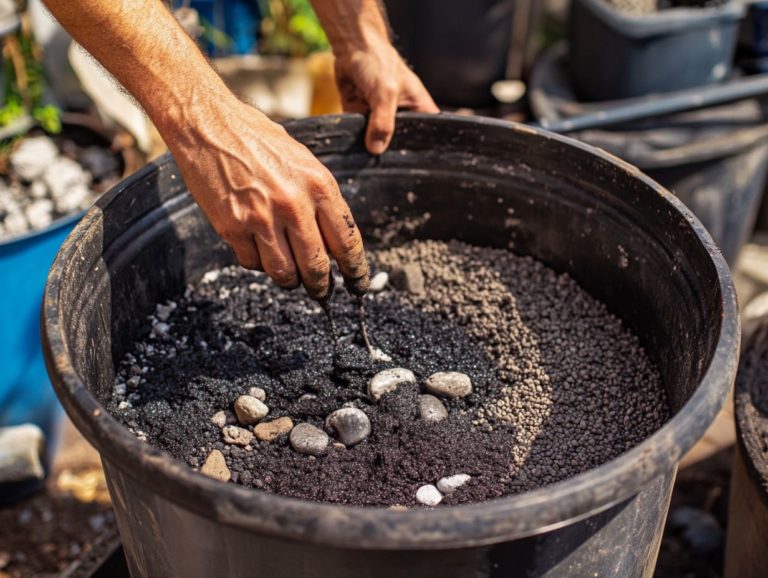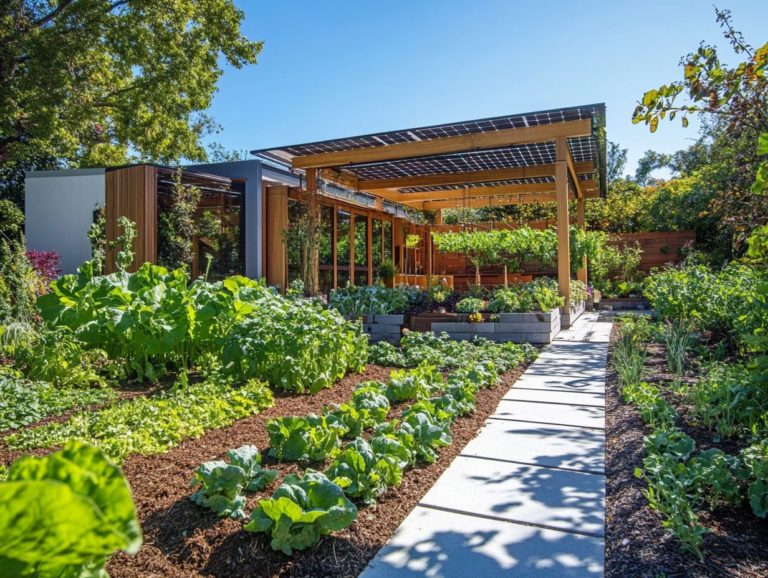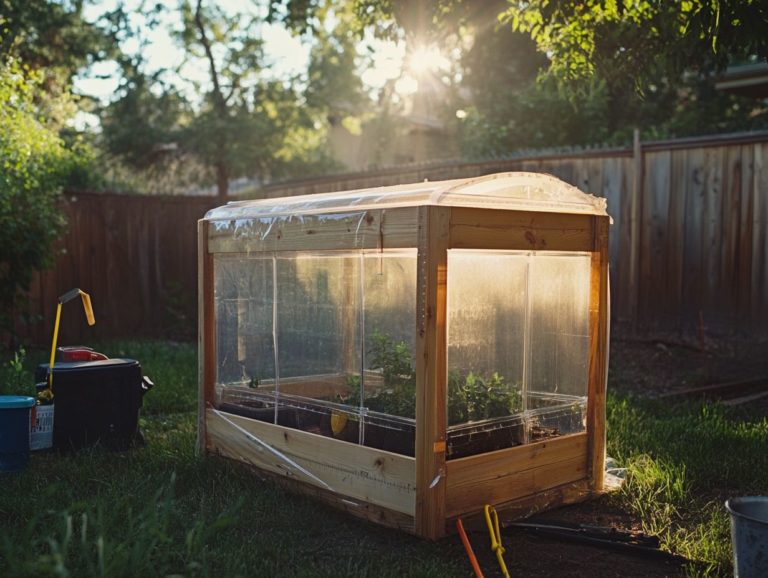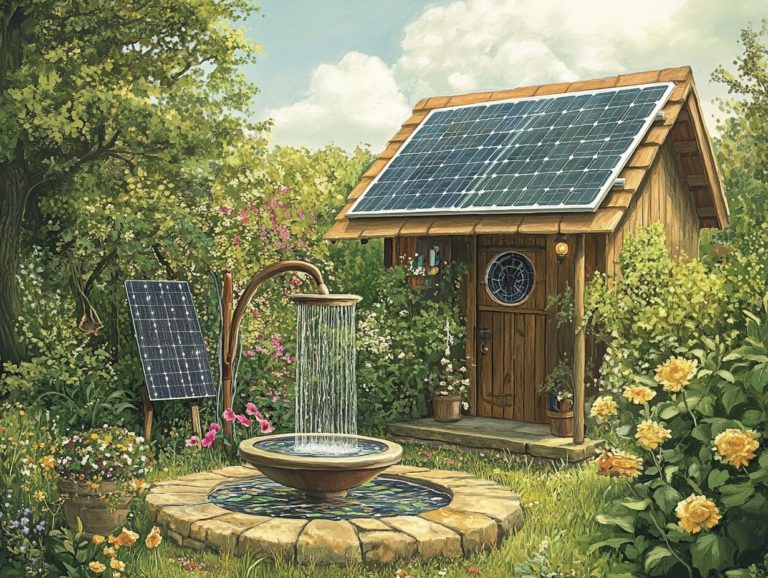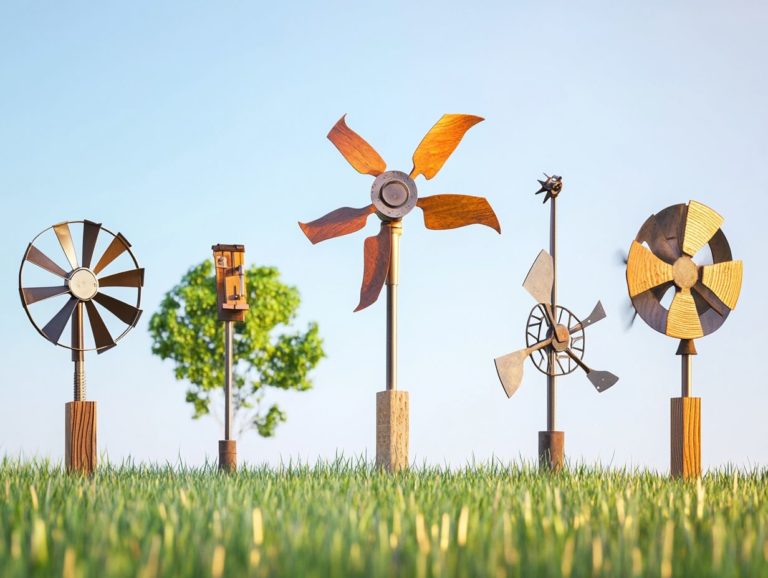5 Unique DIY Projects to Harness Wind Energy
Get ready to dive into the exciting world of wind energy! Harnessing the power of the wind through wind turbines is not just an exhilarating endeavor; it can also be incredibly rewarding, especially when you craft something functional with your own hands.
In this article, you’ll uncover five distinctive DIY projects that enable you to harness wind energy in innovative ways. Whether you’re constructing your own DIY wind turbine or creating a wind-powered phone charger, each project is accompanied by a comprehensive materials list and detailed step-by-step instructions.
Embrace the opportunity to transform those breezy days into sustainable energy solutions and elevate your creativity!
Contents
- Key Takeaways:
- 1. Build Your Own Wind Turbine
- 2. Create a Wind-Powered Water Pump
- 3. Construct a Wind-Powered Generator
- 4. Make a Wind-Powered Electric Car
- 5. Construct a Wind-Powered Phone Charger
- Frequently Asked Questions
- What are the benefits of harnessing wind energy through DIY projects?
- What materials are needed for these 5 unique DIY projects?
- Can anyone do these DIY projects, even with little to no technical knowledge?
- Are these DIY wind energy projects cost-effective?
- How much space do you need?
- Are there any safety precautions to consider when building these DIY wind energy projects?
Key Takeaways:
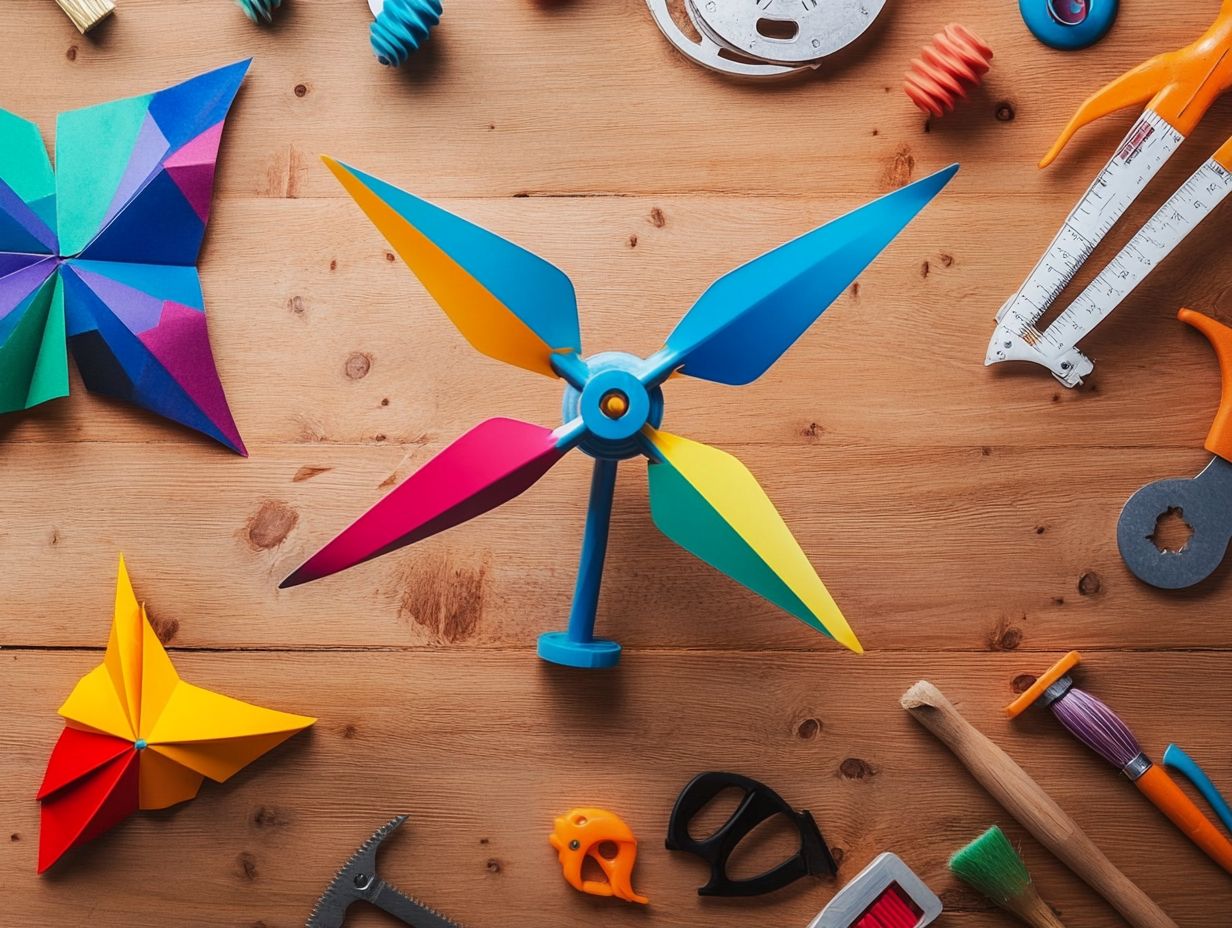
- Harness wind energy through DIY projects to power various devices and reduce reliance on fossil fuels.
- Basic materials and step-by-step guides make it easy to build a wind turbine, water pump, generator, electric car, and phone charger, leveraging clean energy principles.
- These exciting projects save you money while making a positive impact on our planet!
1. Build Your Own Wind Turbine
Building your own wind turbine can be an incredibly rewarding endeavor. You ll have the ability to generate your own energy while contributing to the thriving movement toward renewable energy and sustainable solutions. You ll be thrilled to power your home with clean electricity, decrease your carbon footprint, and lower your electricity bills all while reveling in the creation of a DIY wind turbine tailored to your specific needs and tastes.
This hands-on experience equips you with valuable skills and fosters energy efficiency and resilience in your energy usage. For instance, you can easily construct a simple horizontal axis wind turbine, which has blades that rotate horizontally, using readily available materials. This makes this project accessible for most enthusiasts. Alternatively, you might consider vertical axis turbines, which have blades that rotate vertically and provide a compact solution perfect for urban environments. You could also explore bladeless wind turbines like Vortex Bladeless, which minimize noise and enhance safety. Additionally, check out 5 creative DIY projects to enhance home energy efficiency for more innovative ideas.
By embracing these diverse options, you enable yourself to select models that align with your environmental conditions and personal style, ensuring that you not only contribute positively to your local ecosystem but also enjoy the myriad benefits of sustainable energy generation.
What Materials Do You Need?
To create your own DIY wind turbine, you ll need a carefully curated selection of materials essential for the construction process, ensuring your turbine is efficient and durable in harnessing wind energy for clean electricity generation.
Key components include blades crafted from lightweight yet sturdy materials like PVC or fiberglass, which are designed to effectively capture wind energy. A reliable generator is also necessary to transform the mechanical energy from the turbine into usable electrical power. You will also need a strong tower typically made from metal or wood to elevate the turbine and withstand strong winds. You might also consider integrating advanced materials such as thermoplastic for enhanced durability.
Proper wiring is crucial for connecting all the components, ensuring both safety and efficiency. If sustainability is a priority for you, consider sourcing recyclable materials or repurposed parts from old appliances. Many local scrap yards or online marketplaces offer eco-friendly options, allowing you to reduce the environmental impact of your build while embracing your innovative spirit. You might even use a 3D printer to create customized parts, further enhancing the DIY aspect.
Step-by-Step Guide to Building a Wind Turbine
This guide will teach you how to build a wind turbine. It covers everything from selecting materials to assembling the components and installing your turbine.
By following these detailed instructions, you ll master the art of constructing a functional wind turbine. You will also appreciate the importance of maintaining proper safety measures throughout the project.
Key steps include:
- Selecting a suitable location for maximum wind exposure,
- Carefully choosing components such as blades and generators, possibly considering brands like Automaxx or Ametek,
- Ensuring structural integrity during assembly.
With clear diagrams illustrating each stage, you’ll gain insights into vital connections and equipment placements.
Remember, it s crucial to observe safety precautions. Wear protective gear and secure the area during installation to prevent accidents. This ensures a seamless setup that maximizes your energy production.
2. Create a Wind-Powered Water Pump
A wind-powered water pump is your ticket to an innovative solution that harnesses wind energy to move water efficiently. It presents a sustainable and environmentally-friendly option for all your irrigation and water needs.
This technology allows you to access water without depending on traditional energy sources. In doing so, it promotes energy efficiency and helps you reduce your carbon footprint.
These pumps capture the natural wind currents. They convert the energy of moving air into power to run the pump, delivering water precisely where it s needed.
One of the most attractive benefits of this technology is its cost-effectiveness. With no fuel costs or electricity bills to worry about, you can enjoy significant long-term savings.
The applications are vast. These pumps can water livestock in remote areas and irrigate crops efficiently. For example, at the Northern wind farm in Belgium, farmers have increased their efficiency with this technology.
What Is a Wind-Powered Water Pump?
A wind-powered water pump is an innovative solution that harnesses the kinetic energy of the wind to lift water from a source. It offers an efficient and eco-friendly option for various applications, including irrigation, livestock watering, and even household needs.
These systems typically feature large blades mounted on a rotor. The rotor spins when the wind blows, converting that wind energy into power for the pump.
This mechanical energy is then transmitted through gears to elevate water from rivers, wells, or ponds. Companies like Vestas Wind Systems and MingYang Smart Energy are leaders in developing efficient wind technology for such applications.
In rural areas where electricity might be scarce, farmers have successfully integrated these pumps to irrigate their crops. This significantly reduces their reliance on fossil fuels.
Moreover, in remote regions, livestock owners enjoy the benefits of a consistent water supply generated by wind pumps. This technology not only promotes sustainable practices but also ensures that vital resources remain accessible, regardless of the weather.
Are you ready to harness the wind? Building a wind-powered water pump could change your life! Don’t miss out on this chance to free yourself from traditional energy sources while saving money! To get started, check out these must-have tools for DIY energy projects!
How Does It Work?
The system of a wind-powered water pump elegantly transforms wind energy into mechanical energy, enabling you to pump water easily and effectively. This system brilliantly demonstrates how renewable energy can be harnessed for practical purposes. Innovations like wind energy technologies exemplify the progress in this field.
At the core of this system is a rotor, the part that spins in the wind, that captures the kinetic energy from the wind, setting the entire process in motion. As the wind sweeps by, it turns the blades of the rotor, which are designed carefully for optimal efficiency. This rotational motion is then transmitted through a series of gears that amplify the movement, converting it into powerful spinning energy. This energy drives a piston or diaphragm, creating a suction effect that lifts water from underground sources.
Visual aids such as diagrams can significantly enhance your understanding of this process, clearly illustrating how energy flows from the wind into the mechanical components and ultimately powers the water lifting mechanism. For example, Robert D. Copeland’s designs offer an insightful look into efficient wind-powered systems.
Materials Needed for a DIY Wind-Powered Water Pump
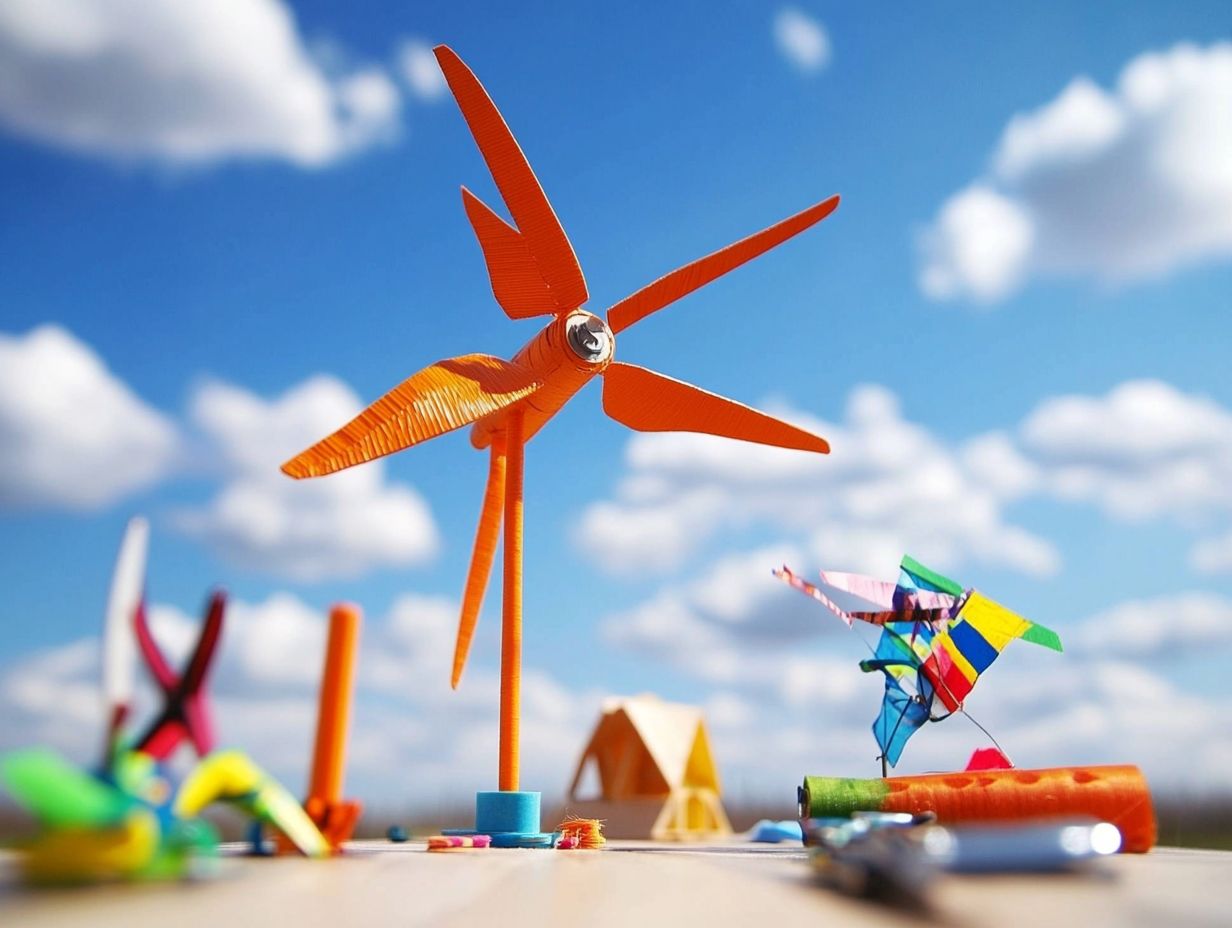
When embarking on the journey of constructing a DIY wind-powered water pump, it is essential to prioritize the right materials. You need components that can endure outdoor conditions while efficiently converting wind energy into a reliable water source.
Every element you select plays a vital role in ensuring the pump’s durability and maximizing its efficiency. For instance, opting for a sturdy, rust-resistant metal for the frame is crucial; it will withstand the elements and resist corrosion over time. Choosing a lightweight yet robust propeller material, such as high-density plastic, can significantly enhance the pump’s ability to harness wind energy without compromising performance. Leveraging offshore wind technologies can further improve the reliability of these systems.
Additionally, consider using an eco-friendly water storage tank made from recycled materials. This not only minimizes your environmental footprint but also provides a dependable reservoir for collected water, supporting sustainability while ensuring the functionality of your system. Collaborating with companies like Clean Energy Ideas can provide more sustainable solutions.
Step-by-Step Guide to Building a Wind-Powered Water Pump
This step-by-step guide lets you quickly build a wind-powered water pump from scratch, ensuring you create a reliable system that can effectively harness wind energy for efficient water lifting. By using cutting-edge wind technology, you can enhance the efficiency of your pump.
As you follow these detailed instructions, you ll learn to assemble various components while navigating essential testing phases to guarantee optimal performance. The guide will lead you through the installation process, ensuring everything is securely positioned and functioning correctly. Companies have made significant strides in integrating wind energy systems into practical applications.
To enhance the longevity and efficiency of your water pump, you’ll also receive thoughtful tips on routine maintenance and performance optimization. This knowledge will enable sustained energy generation and reliable water delivery, allowing you to enjoy the fruits of your labor for years to come. Additionally, understanding renewable energy principles can further enhance your system’s efficiency.
3. Construct a Wind-Powered Generator
Constructing a wind-powered generator allows you to harness wind energy for electricity generation. This gives you access to a clean and renewable power source that can significantly enhance your energy independence and sustainability. Start your journey to energy independence today!
By opting for a DIY approach, you can create a generator customized to your specific energy needs. This helps reduce your reliance on fossil fuels and promotes the use of clean energy technologies developed by companies like MingYang Smart Energy and Vestas Wind Systems.
Before diving into this project, gather the right materials. Lightweight yet sturdy components like PVC pipes for the frame, a reliable generator from Automaxx or Ametek, and blades made from durable materials will serve as the backbone of your design.
Always prioritize safety! Wearing protective gear, such as gloves and goggles, while assembling the parts can help prevent injuries. Consider using components like thermoplastic and recycled materials to enhance safety and sustainability.
Take the time to explore various designs. Options range from small-scale personal units to larger models like Haliade-X turbines. Innovations such as bladeless wind turbines and vertical axis turbines are renowned for their efficiency in capturing wind energy.
Understanding the energy production capabilities of these systems is essential for anyone looking to invest in sustainable solutions. These solutions not only benefit the environment but also enhance communities. The Norther wind farm in Belgium is a testament to how communities can thrive on wind technology.
What Is a Wind-Powered Generator?
A wind-powered generator converts wind energy into electrical energy. This allows you to tap into a renewable source for power generation while reducing reliance on conventional fossil fuels.
Typically, these generators feature large blades mounted on a sturdy tower. As the wind flows past them, the blades rotate, setting a rotor in motion that is connected to a generator. This effectively transforms the kinetic energy of the wind into electricity.
In rural settings, small wind turbines can provide power for individual homes, while larger installations can supply energy for entire communities. This versatility showcases the generator s potential for both residential electricity and comprehensive commercial energy solutions.
How Does It Work?
The operation of a wind-powered generator captures wind energy through blades that spin a rotor. The rotor’s movement is then transformed into electrical energy by a generator. This process exemplifies the efficiency of wind energy in electricity production.
The wind interacts with the turbine blades, which are designed to optimize lift while minimizing drag. This allows them to rotate effectively even in less-than-ideal wind conditions. As the blades turn, they drive the rotor connected to a generator. Here, electromagnetic induction the process that converts movement into electricity works its magic.
This generated electricity is transmitted through power lines, ready for use in homes and industries. To enhance your understanding, consider adding diagrams illustrating the function of each component. This will provide a clear visualization of how wind energy is harnessed, showcasing the balance between technology and nature.
Materials Needed for a DIY Wind-Powered Generator
Gathering the right materials is crucial for your DIY wind-powered generator. This ensures all components work together to convert wind energy into usable electricity.
To embark on this sustainable journey, you ll need to collect several key materials, including:
- a suitable generator.
- sturdy blades crafted from lightweight yet durable plastic or wood.
- a tower for height adjustment.
- proper wiring to connect all the parts.
Think of the generator as the heart of your system, transforming movement energy into electricity. The blades capture the wind s force. Some innovative ideas include using a 3D printer to create custom components. A tall tower will maximize wind exposure, ensuring optimal performance, and high-quality wiring will guarantee efficient power transmission.
Why not get creative with recycled materials? It s a fun way to enhance sustainability and reduce your impact on the environment.
Step-by-Step Guide to Building a Wind-Powered Generator
This comprehensive step-by-step guide will lead you through the process of building a wind-powered generator, equipping you with the knowledge necessary to create a reliable and effective source of renewable energy.
By following the outlined instructions, you ll gain valuable insights into selecting the right materials, grasping the assembly process, and implementing safe practices throughout your project. From conducting a site assessment checking the location for wind potential to mounting your generator, this guide provides practical advice on securely attaching components and connecting the electrical systems.
This guide covers troubleshooting techniques to help you identify and fix issues such as inconsistent power output or mechanical failure.
Prepare yourself with essential safety tips to mitigate potential hazards, ensuring a smooth and successful construction experience.
4. Make a Wind-Powered Electric Car
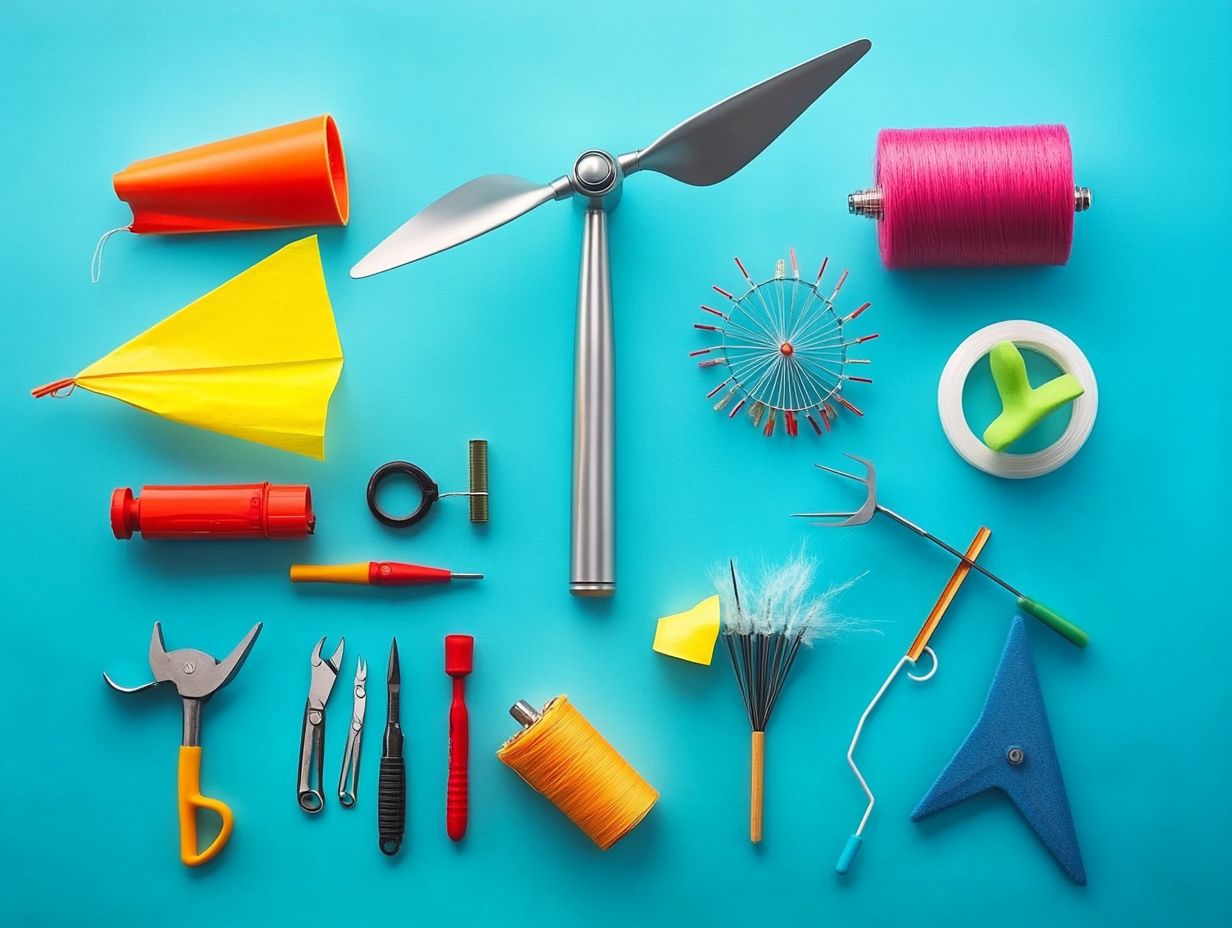
Creating a wind-powered electric car allows you to embrace the innovative use of wind energy alongside cutting-edge automotive technology. This offers a sustainable solution for environmentally conscious drivers eager to lessen their impact on the environment. This approach not only harnesses the wind’s power to fuel electric propulsion but also aligns with the larger mission of clean energy adoption and enhanced energy efficiency in transportation.
By incorporating lightweight materials like carbon fiber and optimizing aerodynamics in the design, you can maximize energy efficiency. This significantly boosts the vehicle’s viability. Some groundbreaking projects, spearheaded by universities and startups, have successfully developed prototypes featuring retractable wind turbines. These turbines can generate additional energy whether the vehicle is stationary or in motion, marking a noteworthy leap forward in sustainable transportation.
Such innovations highlight the transformative potential of wind energy in reshaping the automotive landscape. They pave the way for eco-friendly alternatives that diminish reliance on fossil fuels and promote greener commuting options. Join the movement toward eco-friendly driving now!
What Is a Wind-Powered Electric Car?
A wind-powered electric car is an innovative vehicle that harnesses wind energy either directly or indirectly to generate electricity for propulsion, marking a significant advancement in sustainable transportation solutions.
By utilizing rooftop turbines or integrated wind-catching systems like those proposed by Makani, these vehicles effectively convert the kinetic energy of the wind into stored power for your journeys. In stark contrast to traditional gasoline-powered cars that spew harmful pollutants and contribute to greenhouse gas emissions, wind-powered electric cars run on clean, renewable energy, significantly minimizing your impact on the environment.
Picture this: a fleet of wind-powered vehicles cruising along coastal regions, tapping into an abundant energy source that allows for longer trips without the need for fossil fuels. This transition enhances energy efficiency and paves the way for a cleaner environment for generations to come. Wind-powered electric cars can also significantly lower electricity bills for users.
How Does It Work?
The mechanics of a wind-powered electric car revolve around using the strength of wind energy to charge batteries or drive electric motors directly. This method showcases a sophisticated approach to promoting clean energy within the automotive sector.
Imagine vehicles equipped with wind turbines elegantly mounted on their exteriors, designed to capture the kinetic energy from swirling air currents. Some innovative designs even feature airborne wind turbines, which can catch wind from any direction, to maximize efficiency. When the wind sweeps over these turbines, it sets them in motion, converting kinetic energy into moving energy.
This moving energy is subsequently transformed into electrical energy by a generator connected to the turbines. The electricity generated can be stored in onboard batteries for later use or utilized immediately to power the electric motors. Companies like Power Technology and Robert D. Copeland are at the forefront of this technology. This innovative system not only extends the vehicle s range by augmenting traditional charging methods but also underscores a commitment to sustainable transportation by reducing dependence on nonrenewable energy sources. Now is the perfect time to embrace innovative clean energy solutions in the automotive sector.
Materials Needed for a DIY Wind-Powered Electric Car
For your DIY wind-powered electric car project, grasping the necessary materials is essential to ensure your vehicle operates efficiently and makes the most of wind energy for propulsion.
Key components for this innovative endeavor include high-efficiency turbines and vertical axis turbines, which can catch wind from any direction, that can effectively capture wind energy even at lower speeds. Pair these with robust batteries designed to store this energy for future use. Electric motors will be pivotal, converting the stored power into motion, while lightweight yet durable materials such as thermoplastic are crucial for optimizing performance.
Sourcing these components sustainably not only benefits the environment but also sparks creativity in your design process. This can lead to unique solutions that leverage local resources or innovative recycling methods. This project embodies the essence of sustainable engineering and wind technology, seamlessly blending functionality with a commitment to environmental responsibility.
Step-by-Step Guide to Building a Wind-Powered Electric Car
This comprehensive guide helps you navigate the intricate process of building a wind-powered electric car. Engaging with this project places you at the forefront of sustainable transportation solutions and allows you to harness the power of wind energy and renewable energy.
With meticulous planning and a keen eye for detail, assembling this innovative vehicle transforms into an exhilarating project that contributes to environmental conservation while sharpening your technical prowess.
The instructions will lead you through various stages, from selecting the ideal components like wind turbines and electric motors to seamlessly integrating them into the car’s frame. It s essential to optimize the placement of the wind turbines to maximize energy capture and electricity generation, ensuring your vehicle operates efficiently even in less favorable wind conditions.
By following this guide, you can create a unique vehicle that serves as a remarkable testament to both creativity and sustainability, incorporating elements like clean energy and energy independence.
Start your project today and join the movement towards sustainable transportation!
5. Construct a Wind-Powered Phone Charger
A wind-powered phone charger offers you a creative and practical way to harness wind energy for your everyday needs. With this innovative solution, you can charge your devices sustainably while actively contributing to the transition toward clean energy. By designing a DIY wind-powered charger, you promote energy independence and reduce your reliance on traditional electricity sources and electricity bills.
To embark on this inventive journey, you will need some essential materials: a small wind turbine, a device to change AC to DC, and a power manager to handle the energy delivery to your device. Consider using a 3D printer to create custom parts. For inspiration, check out these 10 DIY projects to reduce your carbon footprint. Gather these components and follow this straightforward process:
- Assemble the turbine put together the blades and base.
- Connect it to the device that changes AC to DC.
- Attach the power manager.
In terms of optimizing energy production, consider placing your charger in an open area with consistent wind flow. Ensure that the turbine is mounted high enough to capture those stronger breezes. For inspiration, you could explore offshore wind setups.
Embrace wind energy for your devices today! By using wind energy for your personal electronics, you not only minimize your carbon footprint but also support a broader movement toward renewable energy, ultimately helping to create a sustainable future.
What Is a Wind-Powered Phone Charger?
A wind-powered phone charger is a remarkable device that allows you to harness wind energy to charge your mobile devices, offering a sustainable alternative to traditional chargers that depend on grid electricity. Companies like Automaxx have been pioneers in this space.
This innovative gadget typically features a small wind turbine, a generator, and a power manager, all seamlessly integrated into a compact unit. When the wind picks up, the turbine blades start to spin, converting mechanical energy into electricity through the generator. You might even consider experimenting with a bladeless wind turbine for quieter operation. The power manager ensures that your mobile device receives an optimal charge, protecting it from any risk of overload.
By embracing this eco-friendly technology, you can adopt clean energy practices, reducing your reliance on fossil fuels and minimizing your carbon footprint, all while keeping your devices powered up in a responsible and environmentally conscious manner.
How Does It Work?
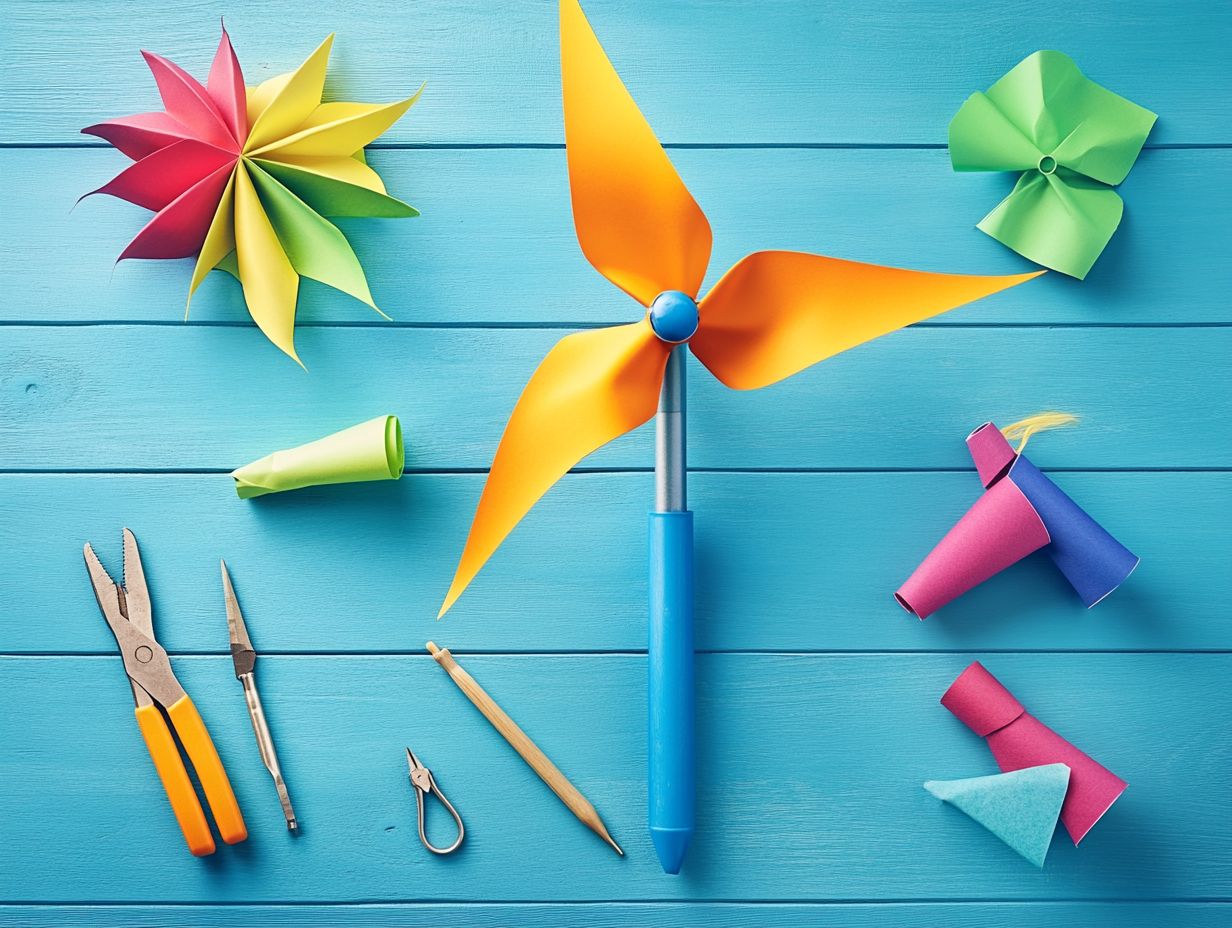
The mechanism behind a wind-powered phone charger is a fascinating blend of technology and nature, capturing the wind s energy through a turbine to generate electrical current for charging your devices. This illustrates the practical applications of renewable energy and energy efficiency seamlessly integrated into your daily life.
It all begins with the turbine’s blades, meticulously engineered to catch the wind. As the wind sweeps over these blades, it generates lift, setting them into motion. The spinning motion is then sent to a generator, where the kinetic energy of the turbine is transformed into electrical energy through a simple process that converts motion into electricity. The electricity produced can either be stored in batteries or used directly to power your devices, allowing you to harness nature’s energy effortlessly. Innovations like Makani are pushing the boundaries further with their airborne wind turbine technologies.
To enhance your understanding of this sustainable charging solution, diagrams depicting the various components such as the turbine, generator, and storage units can provide valuable insights into how everything works together. Discover more about exciting projects from companies like Vestas Wind Systems and MingYang Smart Energy now!
Materials Needed for a DIY Wind-Powered Phone Charger
To successfully build a DIY wind-powered phone charger, you ll need specific materials to efficiently convert wind energy into electrical power for charging your mobile devices. DIY wind turbine projects can provide helpful insights.
Select high-quality components for the best performance and reliability. Start with a robust wind turbine kit, ideally from companies that prioritize sustainable manufacturing practices. Look into brands like Ametek for reliable components. This choice guarantees durability and minimizes your environmental impact.
A good charge controller is crucial for safe energy management. It prevents overcharging and protects your batteries from damage. Choose quality batteries designed for renewable energy applications; they should effectively store energy without degrading too quickly. Consider adding solar panels for even greater energy efficiency!
Don t overlook the importance of eco-friendly wiring and recyclable casing. By sourcing these materials, you ensure that your charger aligns with sustainability principles, making your project not only functional but also environmentally responsible. You may also consider materials used in offshore wind projects for added durability.
Step-by-Step Guide to Building a Wind-Powered Phone Charger
This step-by-step guide equips you with essential knowledge to craft a wind-powered phone charger. Harness clean energy for your devices and diminish your reliance on conventional energy sources. Projects like these are part of broader clean energy ideas gaining traction worldwide.
By following these assembly instructions, you can ensure that each component is fitted correctly for maximum efficiency. Begin by sourcing high-quality materials designed to withstand outdoor conditions while ensuring that the charger operates effectively. Innovations like the Haliade-X turbine inform the principles of maximizing energy capture.
Prioritizing safety is vital; wear gloves when handling electrical components to prevent injuries. A reliable voltage regulator is essential to safeguard your devices from power surges. Companies like General Motors emphasize safety in their innovations, offering useful guidance.
To enhance performance, position your charger in an area with consistent wind flow. Maintain it regularly to prevent buildup that could hinder functionality. Consider studying large-scale wind farms like the Norther wind farm in Belgium for insights.
Frequently Asked Questions
What are the benefits of harnessing wind energy through DIY projects?
DIY wind energy projects offer benefits like reduced electricity costs, increased energy independence, and a smaller carbon footprint. These projects also provide a deeper understanding of electricity generation.
What materials are needed for these 5 unique DIY projects?
The materials needed vary depending on the project, but common items include PVC pipes, generators, batteries, and blades. For advanced projects, consider components used by companies like Power Technology.
Can anyone do these DIY projects, even with little to no technical knowledge?
Yes! These projects are achievable by anyone with basic DIY skills and some guidance from online tutorials or instructional books. Enthusiasts have used platforms like Robert D. Copeland s resources for additional support.
Are these DIY wind energy projects cost-effective?
In the long run, DIY projects can save you money on electricity bills and reduce reliance on traditional energy sources, making them a cost-effective option. They also contribute to the broader adoption of clean energy.
How much space do you need?
The amount of space required depends on your specific project. Most setups can fit in a backyard or small open area. Smaller setups like Edy turbines are perfect for limited spaces.
Start your DIY wind-powered phone charger today and join the movement toward sustainable energy solutions!
Are there any safety precautions to consider when building these DIY wind energy projects?
Absolutely! Taking safety precautions is crucial while building wind energy projects. Carefully follow all instructions and wear protective gear when needed.
Check out safety guidelines from experts like Haliade in Arizona; they offer valuable tips.

